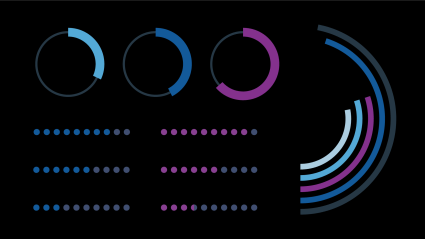With 2021 fast approaching, it’s time to consider the top predictions and telling trends that will shape (and disrupt) the future of marketing.
That’s why we fired up our Digital Marketing Deloreans and set out to answer a key question: how do we predict a future in a present that’s constantly changing?
We invited some of the very people shaping this future to share their insights and show us the way to the marketing of tomorrow: Grace Kao, Head of Global Business Marketing at Instagram, Julian Duncan, CMO/SVP of Social Responsibility & Impact at Jacksonville Jaguars, and Courtney Fadjo-Biro, Head of Growth Marketing at Zenni.
WATCH NOW
Here’s their informed forecast for what will define what successful marketing will look like as we head into a new year.
1. Agile marketing requires actively listening to your customers’ needs—and doing fewer things, better.
Given the rapid changes in customer expectations, combined with customers’ increased appreciation of and dependence on all things digital, it’s now more important than ever to make investments that empower your organization to make fast, effective decisions and quickly adapt to new information with the most relevant customer messaging and offers.
But agile marketing isn’t just about speedy reactions: brands must also position themselves to meet customer needs more holistically, and authentically, by following these critical steps:
- Actively listen: Brands need to listen to their audiences more: what they care about, what they’re passionate about, what they’re stressed about. With great access to platforms where people are actively sharing what they’re thinking comes great responsibility. Brands and marketers need to be actively listening, understanding, and supporting the issues that matter most to their audiences.
- Be customer-obsessed: Lead through the customer, and do it confidently! Think of your customer as the other member of your marketing team that you have to run your decisions by. Get rid of anything that doesn’t serve the customer and build the right processes and relationships within the business to deliver on your brand’s promises.
- Do less: Truly agile marketing requires doing fewer things, better. Brands should develop a smaller set of high-impact priorities that allow for greater flexibility and nimbleness, while also maintaining a level of sincerity and authenticity at every touchpoint.
“Remove the fear of failure, and applaud the bravery of reacting to external stimuli in the right way. Having a firm foundation, and then making bravery a part of your culture, is critical when it comes to agility.”
2. Brands should embrace authentic marketing by mirroring—and supporting—the values of the communities they serve.
Brands can’t just be efficient, they also need to foster the human connection we all crave. People now invite brands into their lives and expect more from interactions with a business, wherever they occur. And what a brand is willing to stand up for and actually act on is playing a bigger part in purchase decisions.
“As leaders of our brand, we have to be more thoughtful, more clear, and more representative of the communities we serve. If we aren’t delivering on that, our brands will die.”
In fact, one in six customers will stop shopping with a brand if its values are not aligned with their personal beliefs, according to a Criteo survey.
So, how do we strike a balance between our responsibility to business goals and commitment to brand values? It starts by realizing that the two aren’t mutually exclusive: strong brand values make business sense (and will make your employees feel like they’re working toward something meaningful as well).
“Start from the inside: if people in marginalized communities aren’t feeling supported and represented and empowered and comfortable and safe, they will not be able to bring their best. It’s time to do right by your community AND your employees.”
Brands need to realize that it’s in their best interest to be less creepy, and instead invest in showing their human side. Be a leader, not a follower. And remember: if your brand is standing up for something just for today or just because everybody else is doing it, people will know. Be authentic, and make sure your business is meaningfully backing up what they’re putting out publicly.
3. Participation is a two-way street, so open up the conversation with your customers.
If your brand’s version of customer engagement only flows in one direction, you’re leaving a lot of opportunity on the table. The ways marketers communicate with customers are more varied than ever before, and often include channels and strategies that straddle the divide between marketing and audience, from influencer marketing to user-generated content.
Marketers need to prioritize building an engagement strategy that leans heavily into participation and opens the lines of communication to their customers, making them a dynamic part of the brand, not just an audience on the sidelines.
“The future of marketing is going to be a little bit more Deadpool; he breaks the fourth wall. And by doing that, he’s bringing people into the movie. Over the next couple of years, people will want these deeper experiences with brands.”
As that conversation progresses and gets more complex, it’s up to marketers to weave these insights—who’s participating, where they’re engaging, and what’s motivating them—into their marketing strategy. Here’s what brands should keep in mind while crafting their customer engagement strategy:
- Build a holistic participation plan that meets customers where they are in their journey. For example, building awareness and consideration can require promoting community forums and/or relevant blogs.
- Create opportunities for two-way conversations to deepen the customer relationship, to ultimately nurture brand loyalty and customer advocacy.
- Encourage your customers to co-create with you, through user-generated content like video tutorials, testimonials, product innovations, and more.
“Build a relationship with your customer: Listen to their feedback, figure out if you should change course based on what they’ve communicated, and build a true customer feedback loop to guide your actions and decisions.”







Responses